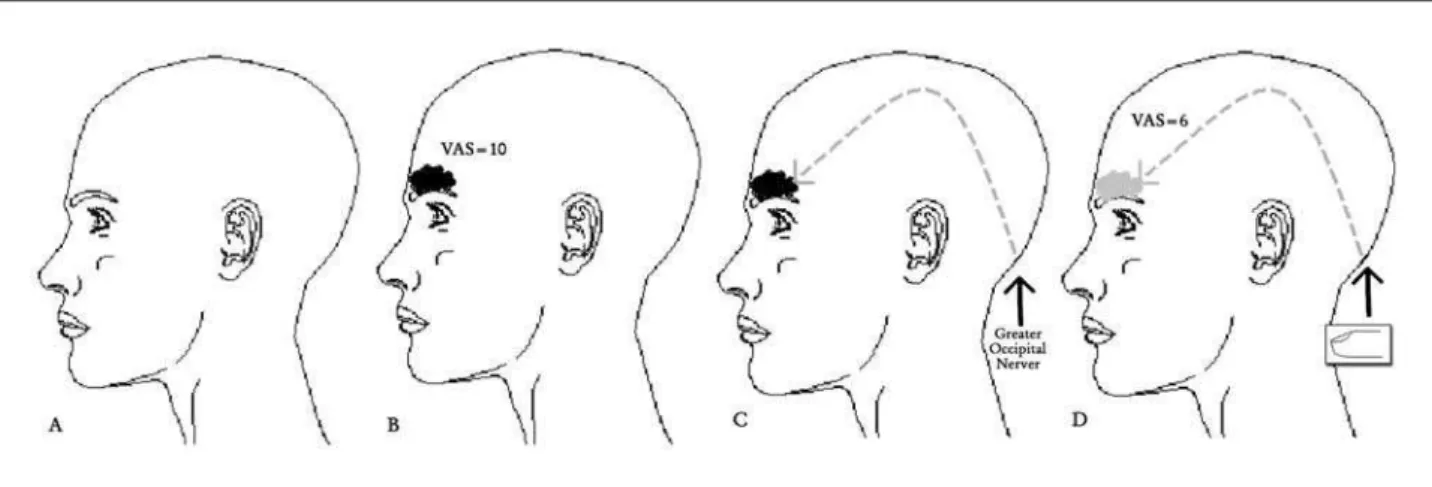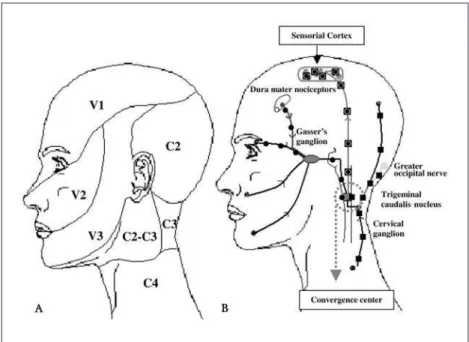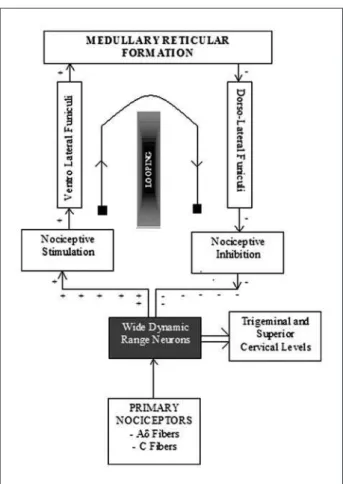MASSAGING OVER THE GREATER OCCIPITAL NERVE
REDUCES THE INTENSITY OF MIGRAINE ATTACKS
Evidence for inhibitory trigemino-cervical
convergence mechanisms
Elcio Juliato Piovesan
1,2, Fabrizio Di Stani
3, Pedro André Kowacs
1,
Rogério Andrade Mulinari
2, Victor Hugo Radunz
2, Marco Utiumi
2,
Eder B Muranka
2, Mario Luiz Giublin
1, Lineu César Werneck
1,2ABSTRACT - Activation of the trigemino-cervical system constitutes one of the first steps in the genesis of migraine. The objective of this study was to confirm the presence of trigemino-cervical convergence mech-anisms and to establish whether such mechmech-anisms may also be of inhibitory origin. We describe a case of a 39-years-old woman suffering from episodic migraine who showed a significant improvement in her fron-tal headache during migraine attacks if the greater occipifron-tal nerve territory was massaged after the ap-pearance of static mechanical allodynia (cortical sensitization). We review trigemino-cervical convergence and diffuse nociceptive inhibitory control (DNIC) mechanisms and suggest that the convergence mecha-nisms are not only excitatory but also inhibitory.
KEy WoRDS: DNIC, inhibitory control of pain, migraine.
Massagem sobre o nervo occipital maior reduz a intensidade dos ataques de migrânea: evidên-cia de mecanismos de convergênevidên-cia inibitórios trigemino-cervical
RESUMo - Ativação do sistema trigemino-cervical constitui um dos primeiros passos na gênese da crise de migrânea. o objetivo do estudo foi descrever um caso clínico que sugere a existência de mecanismos de convergência trigemino-cervical (CTC) e que esses possam ser do tipo inibitórios. Nós descrevemos o caso de mulher de 39 anos com migrânea episódica que mostrou significante melhora em sua cefaléia frontal durante suas crises quando realizava massagem sobre o território do nervo occipital maior ipsilateral a dor. A melhora clínica só ocorria quando a paciente apresentava alodinia mecânica estática (sensibilização cor-tical). Neste estudo nós revisamos os conceitos de CTC e de mecanismos de controle inibitório nociceptivo difuso (MCIN), sugerindo que este último é um elemento comprobatório da presença de CTC do tipo ini-bitório durante as crises de migrânea.
PAlAvRAS-ChAvE: controle de dor, MCIN, enxaqueca.
1headache Unit, Neurology Division, Internal Medicine Department, hospital de Clínicas, Federal University of Paraná, Curitiba PR,
Brazil (hC/UFPR); 2
health Sciences Experimental laboratory, hC/UFPR; 3
Pain Center “Enzo Borzomati”, DEA (Emergency Department) Policlinico Umberto I - University of Rome “la Sapienza”, Rome, Italy.
Received 5 December 2006, received in inal form 22 February 2007. Accepted 17 April 2007.
Dr. Elcio Juliato Piovesan - Serviço de Neurologia / Hospital de Clínicas da UFPR - Rua General Carneiro 181 / 12 andar / Sala 1236 - 80060-900 - Curitiba PR - Brasil. E-mail: piovesan@avalon.sul.com.br
Migraine is a recurring neurologic disorder with a high prevalence and is characterized by headache and autonomic and somatosensory symptoms. Ap-propriate treatment for this disorder reduces the im-pact of the disease on the sufferer, thereby increasing the quality of life. Three levels of therapy are used: prophylactic, pre-emptive and abortive. For abortive (acute) treatment, pharmacological strategies and/or alternative measures are used. Among the alternative techniques, those that stand out are manipulation of
the suboccipital region (greater occipital nerve) using acupuncture or electrical stimulation. Stimulation of the greater occipital nerve in the treatment of head-aches has been recommended for a number of years1
. Recent studies have shown that the use of electronic devices implanted subcutaneously at the base of the skull near where the greater occipital nerve emerg-es is effective in headache control2
cervical convergence (TCC) mechanisms. Electrophys-iological studies have shown that there is an overlap between the trigeminal and cervical nociceptive sys-tems. The duration and intensity of the stimulus re-quired to induce convergence mechanisms, the neu-rons involved in this process, and diagnostic and ther-apeutic techniques that prove the presence of these mechanisms have been described in various studies (Tables 1 and 2). one of the possible mechanisms by which stimulation of the greater occipital nerve pro-duces pain control is through the ability of this stim-ulus to produce diffuse nociceptive inhibitory control (DNIC). DNIC has been described as one of the most important mechanisms for the control of acute pain. It promotes nociceptive inhibition of neurons locat-ed inside the trigeminal dorsal horn (trigeminal nu-cleus caudalis) following an intense pain stimulus in this region. This pain stimulus promotes local noci-ceptive inhibition, a phenomenon that is known as counter irritation4.
We describe a migraine sufferer who showed a signiicant, transitory improvement in her pain fol-lowing mechanical stimulation of the greater occip-ital nerve ipsilateral to the migraine. The indings described in this case report reinforce the existence of trigemino-cervical convergence mechanisms and
3 seconds, followed by a heavy sensation in the frontal region associated with nausea. The discomfort in this re-gion (2 points on the visual Analog Pain Scale) (vAS=2) evolves slowly until it becomes intolerable after 120 min-utes (vAS=10). At this stage, it is a unilateral throbbing headache, which worsens with the slightest physical effort. At the end of four hours, the patient reports a sensation of pain above the upper right molar (where she had root canal treatment 10 years ago), which worsens with minor pressure (closing the jaws tightly) (Fig 1). The autonomic symptoms accelerate within 120 minutes, and the patient experiences incapacitating vomiting. The patient reported that she massages the right greater occipital nerve territo-ry to reduce the pain. Five seconds after starting to mas-sage the area, the pain decreases from vAS 10 to vAS 6, and the pain sensation above the right molar disappears. Ten seconds after stopping the massage ipsilateral to the pain, the pain symptoms reappear (vAS 6 to 10), as does the allodynia above the right molar. The patient did not re-port tenderness sensation around the GoN region during migraine attacks. In few attacks nausea and vomiting oc-curs. headache history starts twelve years ago. Pharmaco-logical treatment, which consists of a mixture of diluted di-pyrone and metroclopramide administered intravenously, induces sleep, with pain and autonomic symptoms (nausea and vomiting) disappearing completely approximately ive hours later. The patient chose not to undergo prophylactic treatment. Skull tomography and magnetic resonance im-aging of the brain and cervical spine (column) are normal.
Fig 2. Convergence mechanisms between cervical and trigeminal nociceptive sys-tem. (A) Nociceptive distribution of the trigeminal and cervical system; (B) Ilustra-tive convergence mechanisms during the migraine attacks. Trigeminal input´s; cervical input´s; trigeminal and cervical convergente input´s.
Table 1. Electrophysiological and immunohistochemical laboratory studies to prove the existence of trigemino-cervical conver-gence. For convergence mechanisms to take place clinically, there must be a nerve that induces and a nerve that is induced, and both must have clinical manifestations.
Methods Stimuli/species Primary neuron #1 inductor neuron
Primary neuron #2 induced neuron
Features
trigemino-cervical relex15
electrical/ human supraorbital (v1 trigeminal branch)
sternocleidomastoid (C1-C4)
– sternocleidomastoid contraction
trigemino-cervical sensitization16
chemical-electrical/rats GoN (C1-C2) meningeal neurons v1-trigeminal
• trigeminal sensitization
trigemino-cervical sensitization17
extraction incision tooth/rats
alveolar nerve (v2 trigeminal branch)
v1-trigeminal branches
• activation in bilateral neurons of the TNC and spinal cord trigemino-cervical
sensitization18
mustard oil/rats supratentorial dura mater (v1) trigeminal branch
greater occipital nerve
• enlargement of the (T-C) cutaneous mechano-receptive ields • increased excitability to electrical stimulation of the GoN
trigemino-cervical sensitization16
electrical and mustard oil/ rats
GoN (C1-C2) dura mater (v1) trigeminal branch
• enhanced afferent dural input
• increased excitability of dural responses trigemino-cervical
sensitization19
electrical/cats SSS (v1 trigeminal) GoN (C1-C2)
TNC and upper cervical spinal cord (C1-C2)
• input from the superior sagittal sinus and the occipital nerve c-fos20 electrical/ mechanical
macaque, cats and rats
SSS (v1 trigeminal) upper cervical spinal cord (C1-C2)
• fos expression in the TNC and dorsal horn of the C1 and C2 metabolic and
vascular activity21
electrical/rats SSS (v1 trigeminal) upper cervical spinal cord (C1-C2)
• blood low and metabolic activity
increase in the TNC and lCN metabolic activity
(2-deoxyglucose autoradiography)22
The patient has a family history (mother and sister) of mi-graine without aura.
The patient provided written informed consent, as re-provided written informed consent, as re-quired by appropriate local (and national) committees on the protection of research subjects.
DISCUSSION
We describe the case report of a patient suffer-ing from migraine without aura preceded by primary stabbing headache who, during the evolution of the clinical picture, presented with signs and symptoms suggestive of cortical hypersensitization character-ized by static mechanical allodynia. Diffuse nocicep-tive inhibition was triggered by massaging over the greater occipital nerve. The features of this case char-acterize inhibitory trigemino-cervical convergence mechanisms.
Stimuli on the trigeminal nociceptors producing clinical trigeminal and cervical responses, and vice versa, characterize trigemino-cervical convergence mechanisms (Fig 2). These mechanisms can be inhibi-tory or excitainhibi-tory: inhibiinhibi-tory mechanisms are related to diffuse nociceptive inhibitory control, and excit-atory mechanisms are observed in cases of migraine or cervicogenic headache or other myofascial syn-dromes (Table 1 and 2). our daily observations in clin-ical practice suggest that the relationship between
the intensity of the stimulus and the type of inhibi-tory or excitainhibi-tory clinical response in trigemino-cervi-cal convergence mechanisms is not fully understood, and indeed there is much controversy regarding this in the literature. The underlying disease and noci-ceptive tonus the patient presents while the conver-gence mechanisms are in action may inluence the direction in which this response is targeted. For ex-ample, migraineurs can beneit from the pain relief afforded by electrical stimulation of the GoN. In con-trast, stimulation of the GoN during asymptomatic periods can induce migraine attacks. As previously mentioned, these data suggest that trigemino-cervi-cal convergence in migraine can be involved in inhib-iting, inducing or potentializing pain (Tables 1 and 2). Recently Afridi et al have suggested that tender-ness around the region of the GoN was signiicantly associated with a positive response to the anesthetic injection. This suggests that tenderness may be use-ful in selecting out patients who are more likely to respond5
. Diffuse noxious inhibitory control may be deined as the inhibition of nociceptive neurons in the spinal and trigeminal dorsal horns produced by a noxious stimulus applied to any body region remote from the neuron’s excitatory receptive ield6
. The anatomical and neurophysiological basis of DNIC has been studied in detail in experimental and
behavior study25 chemical/ humans GoN (C1-C2) v1 (trigeminal
branch)
• pain over the v1 territory
• h2o
induced pain
pressure algometry26
visual/humans (v1) ophthalmic trigeminal branch
GoN (C1-C2)
• Reduced pain threshold over the GoN
• no drugs
cervicogenic headache27
dysfunctions in cervical structures/ humans
cervical (C1-C3)
v1 (trigeminal branches)
• pain starts in occipital and suboccipital regions with frontal irradiation
• GoN blocked recovery from the pain symptoms
cluster and episodic and chronic migraine28,29
electrical stimulation/ humans
GoN and suboccipital regions
v1 (territory) • headache, such as cluster and episodic and chronic migraine
• GoN stimulation headaches improved
clinical models7,8. The effect of DNIC has been proved
in studies of the trigeminal nociceptive system (i.e. blink relex and trigeminal-mediated relex)9. DNIC
is mediated by a loop established by the spino-bul-bospinal circuit, producing a post-synaptic inhibitory system6 that acts directly on the wide-dynamic-range
neurons10
(Fig 3). The inhibitory control produced by DNIC acts speciically on spinal and trigeminal wide-dynamic-range (WDR) neurons. DNIC can be acti-vated by stimuli that are not painful, as in the case described (in which the greater occipital nerve was massaged); however, the extent of its inhibitory ef-fect depends on the intensity of the initial stimulus. This could explain why DNIC is more effective at in-hibiting secondary (inlammatory) pain than prima-ry (neurogenic) pain11. Recent studies have shown
that pain modulatory systems subserving DNIC are impaired in both migraine and chronic tension-type headache12, as well as in other pain situations such
as ibromyalgia13.
The patient in this study also presented with pain in the right molar region, which was aggravated when her teeth were subjected to mild compression
(mechanical static allodynia). These indings, togeth-er with the presence of primary stabbing headache, characterize cortical sensitization.
Self-administered pain-relieving maneuvers in migraine such as massage over different regions of the skin produce scarce results in a good or excellent pain control. Moreover, the eficacy of maneuvers is often momentary, wearing off when the manoueu-vre stopped. In spite of this, 46% of the subjects used the maneuvers constantly, at each attack. however, that study the massage over the GoN is limited to few patients to make some conclusions14.
In conclusion, showed a case suggestive of inhibi-tory trigemino-cervical convergence mechanisms dur-ing a migraine without aura attacks. The initial stimu-lus originated in the greater occipital nerve following light massage. The inhibitory mechanisms (DNIC) only come into operation after cortical sensitization (the presence of stabbing headache and static mechanical allodynia) and are only able to reduce the intensity of the pain. The duration of this improvement is di-rectly proportional to the duration and intensity of the stimulus over the greater occipital nerve.
REFERENCES
1. Picaza JA, Hunter SE, Cannon BW. Pain suppression by peripheral nerve stimulation: chronic effects of implanted devices. Appl Neuro-physiol 1977;40:223-234.
2. Weiner RL, Reed KL. Peripheral neurostimulation for the control of in-tractable occipital neuralgia. Neuromodulation 1999;2:369-275. 3. Weiner RL. Occipital neurostimulation (ONS) for treatment of
intrac-table headache disorders. Pain Med 2006;7(Suppl 1):S137-S139. 4. Bouhassira D, Danziger N, Attal N, Guirimand F. Comparison of the
pain suppressive effects of clinical and experimental painful condition-ing stimuli. Brain 2003;126:1068-1078.
5. Afridi SK, Shields KG, Bhola R, Goadsby PJ. Greater occipital nerve in-jection in primary headache syndromes: prolonged effects from a sin-gle injection. Pain 2006;122:126-129.
6. Villanueva L, Le Bars D. The activation of bulbo-spinal controls by pe-ripheral nociceptive inputs: diffuse noxious inhibitory controls. Biol Res 1995;28:113-125.
7. Willer JC, Roby A, Le Bars D. Psychophysical and electrophysiologi-cal approaches to the pain-relieving effects of heterotopic nociceptive stimuli. Brain 1984;107:1095-1112.
8. Skljarevski V, Ramadan NM. The nociceptive flexion reflex in humans. Pain 2002;96:3-8.
9. Ellrich J, Treede RD. Characterization of blink reflex interneurons by activation of diffuse noxious inhibitory controls in man. Brain Res 1998;803:161-168.
10. Le Bars D, Dickenson AH, Besson JM. Diffuse inhibitory controls (DNIC). Effects on dorsal horn convergent neurones in the rat. Pain 1979;6:283-304.
11. Price DD, McHaffie JG. Effects of heterotopic conditioning stimuli on first and second pain: a psychophysical evaluation in humans. Pain 1988;34:245-252.
12. Sandrini G, Rossi P, Milanov I, Serrao M, Cecchini AP, Nappi G. Ab-normal modulatory influence of diffuse noxious inhibitory controls in migraine and chronic tension-type headache patients. Cephalalgia 2006;26:782-789.
13. Lautenbacher S, Rollman GB. Possible deficiencies of pain modulation in fibromyalgia. Clin J Pain 1997;13:189-196.
14. Zanchin G, Maggioni F, Granella F, Rossi P, Falco L, Manzoni GC. Self-administered pain-relieving manoeuvres in primary headaches. Ceph-alalgia 2001;21:718-726.
20. Goadsby PJ, Hoskin KL. The distribution of trigeminovascular affer-ents in the nonhuman primate brain Macaca nemestrina: a c-fos immu-nocytochemical study. J Anat 1997;190:367-375.
21. Goadsby PJ, Zagami AS. Stimulation of the superior sagittal sinus in-creases metabolic activity and blood flow in certain regions of the brain-stem and upper cervical spinal cord of the cat. Brain 1991;114:1001-1011.
22. Goadsby PJ, Knight YE, Hoskin KL. Stimulation of the greater occipi-tal nerve increases metabolic activity in the trigeminal nucleus cauda-lis and cervical dorsal horn of the cat. Pain 1997;73:23-28.
Cephalalgia 2001;21:184-188.
27. Antonaci F, Fredriksen TA, Sjaastad O. Cervicogenic headache: clinical presentation, diagnostic criteria, and differential diagnosis. Curr Pain Headache Rep 2001;5:387-392.
28. Peres MF, Stiles MA, Siow HC, Rozen TD, Young WB, Silberstein SD. Greater occipital nerve blockade for cluster headache. Cephalalgia 2002;22:520-522.


